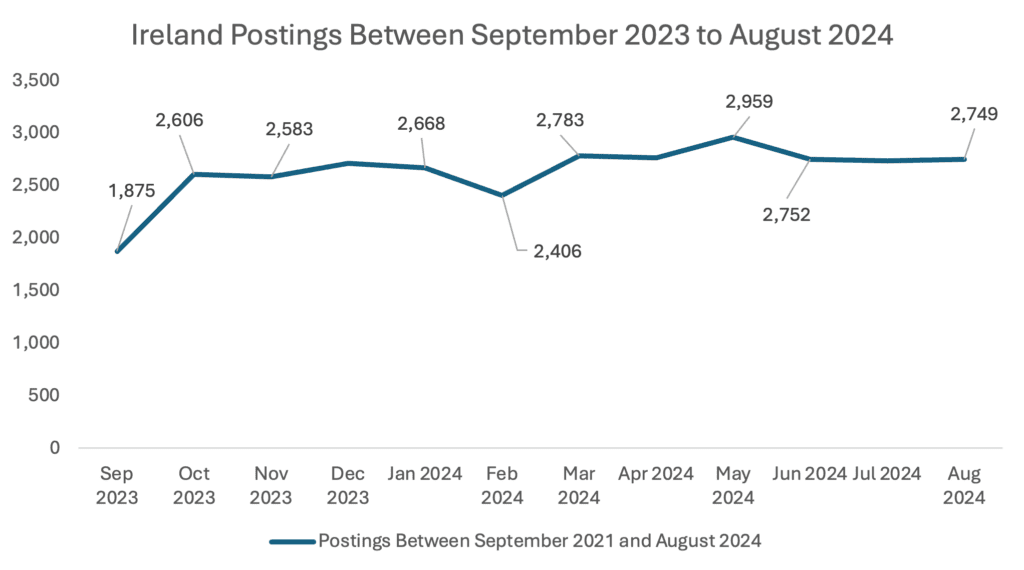How employer demand trends across two countries demonstrate need for AI skills
October 10, 2024, By Kenton Stevens, Senior Research Associate
“What should my artificial intelligence program include in a world full of AI programs?” This is a question my team and I hear a lot, for good reason. Demand for AI professionals is rising quickly, nationally and internationally, and schools need to know how they can support and attract student interest. How then does demand differ across countries, and are these differences significant enough to require targeted curricular design by country? I reviewed employer demand in two countries (the United States and Ireland) in depth to understand these trends.
Methodology
We analyzed job postings between September 2023 and August 2024 for AI professionals (defined as job postings seeking relevant skills such artificial intelligence, generative artificial intelligence, etc., and regardless of educational requirements) in the United States and Ireland. In-demand occupations overwhelmingly align with expected graduate outcomes like Software Developer/Engineer or Data Scientist in both nations.
Employers overwhelmingly want applied, technical skills
We found that the top ten skills mentioned in both Ireland and United States job postings were the same. Notably, the top four skills, all mentioned in over 25% of job postings in both countries for relevant professionals, were machine learning, artificial intelligence, Python, and computer science. While expected, a strong need for technical skills like Python and machine learning in both countries indicates an area where schools may want to consider a more technical curriculum.


Evaluate employer and competitive demand through a Program Feasibility Study
Even after the labor market boom of 2022, historical demand for AI professionals stayed high in the United States
Between September 2021 and August 2024, US employers advertised 1,970,402 postings, which ranged between 211,595 a month at their peak and 82,106 a month at their lowest, suggesting demand even after the market slowed in late 2022.

If you’re thinking about launching either a data science or artificial intelligence program, you may want to consider incorporating both into the curriculum to best prepare students for employment. Within the United States, most AI-relevant occupations relate to data science, software engineering, and computer science. Interestingly, data science appeared as only the 10th most-demanded skill in the United States despite appearing as the top occupation, while within the data scientist occupation, artificial intelligence emerged as the fifth most-demanded skill.

Irish job posting trends indicate robust demand, similar to the United States
Similarly, we see steady demand for AI skills over the last year in Ireland (though the available data doesn’t go back as far in time as for the United States). Specifically, employers advertised more postings after September 2023, with a peak of 2,972 in May 2024, suggesting a similar rising interest in artificial intelligence professionals.

The top 10 occupations for artificial intelligence professionals show a strong preference for data science and computer science.

While some variation occurs across the US and Ireland, employer demands largely apply across both countries and suggest AI programs can address global needs.
Employers and students want to see specific skills in coursework
Most of the AI programs I’ve analyzed tend to feature general artificial intelligence coursework. I see many courses or modules titled “Overview of AI” and “Ethics in AI”, with the occasional specific elective course usually focusing on machine learning. These types of courses can help ensure students understand the broad usage of AI but as noted above, employers (and automatic applicant tracking systems) prefer individuals who can put specific hard skills (e.g., Python) on their resume.
In contrast, take the University of Texas at Austin’s Online Master’s in Data Science. Sample courses in UT’s program include Deep Learning, Machine Learning, and Natural Language Processing—all skills frequently requested by employers. Schools conferring these and similar skills explicitly in their courses could easily demonstrate how their program aligns with both employer and student needs.
It’s important to note this preliminary analysis did not look at the difference between degree-level postings; administrators interested in launching a bachelor’s-level program may notice employers request fewer data science skills and more computer science skills. Understanding the nuances in employer demand could provide the edge your AI program needs and can even act as effective differentiators in recruitment.

More Blogs

The computer science field is changing—here’s how to take advantage
